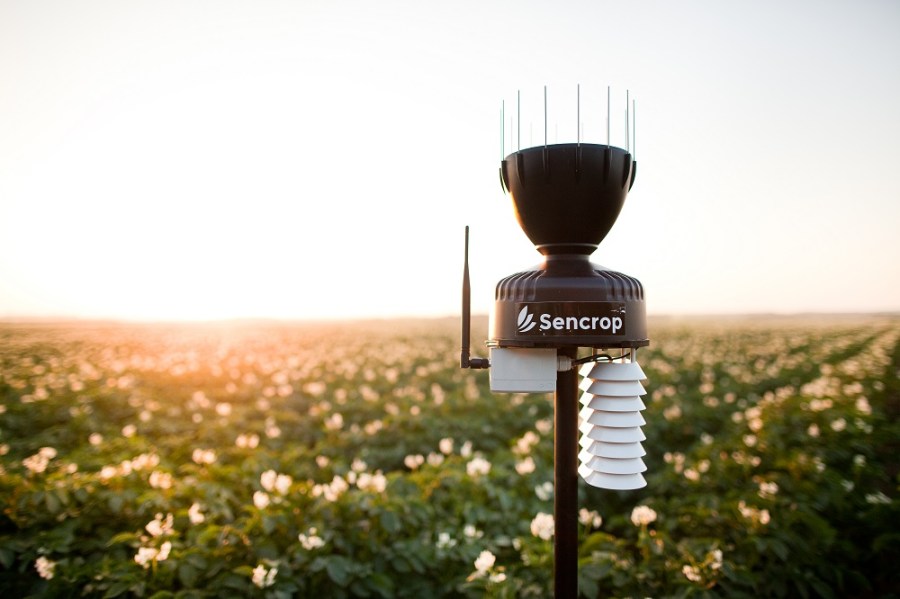Accurate, real-time weather data is vital to farmers, but until now it’s been expensive and difficult to source. CPM takes a look at a new option: Individual farm weather stations which link up to give a detailed local picture.
Now there’s no need to take a chance on spraying and fertiliser applications with a forecast based on observations from several miles away.
By Olivia Cooper
Farmers can now access real-time in-field weather and soil information following the launch of affordable and portable monitoring stations, with linked-up data giving a reliable local picture.
Launched by Sencrop at the Cereals Event, the weather stations enable farmers to see what field conditions are like at any point on the farm, enabling more efficient spraying and harvesting operations. But the real power comes from the ability to share data with other producers, offering a detailed picture of weather on a local, regional and national level.

Further information
A basic weather station – Raincrop – which monitors humidity, air temperature and rainfall – costs £380 plus £150/yr subscription.
Windcrop – which monitors windspeed, direction and gusts – costs £330 plus £150/yr, while Sencrop Plus – Raincrop and Windcrop together – costs £699 plus £180/yr. A leaf wetness sensor is also available for orchards and vineyards. For more information visit sencrop.com.
“Installing a Sencrop unit in one or more fields puts the grower in immediate possession of data unique to that location,” says Fred South at Sencrop. “Automated analysis of this continuous data stream opens up a new and far more objective approach to field operations. Now there’s no need to take a chance on spraying and fertiliser applications with a forecast based on observations from several miles away.”
The stations measure parameters like wind speed, gust and direction, air temperature, humidity, rainfall, soil moisture and soil temperature. And there’s no need to rely on patchy 3G phone coverage or wifi – the units use a low power, long-range network which gives coverage almost anywhere. The portable stations are battery-powered – with rechargeable batteries costing £30 and lasting 3-4 years – meaning they can be moved around the farm according to the crop rotation.
“Previously, weather stations were difficult and costly to install – the whole aim for us was to have something that’s cheap and portable,” explains the firm’s Amber Ogborn. “They are all GPS positioned so you know exactly where they are.” Installation takes around 10 mins, with data online within 15 mins and updated every quarter of an hour, giving real-time information as well as historic details on your computer or smartphone app.
Sencrop has already installed 7000 stations across Europe, where potato growers have cut out up to three blight sprays from their programmes, because the conditions weren’t serious enough to merit spraying – saving them €160/ha (£143/ha), adds Fred. “It gives a new meaning to ‘decision support’.” Farmers can choose to share the data with their agronomists, field operators, and other stakeholders, with both live rainfall monitoring and a seven-day forecast making for information-driven decisions.
It’s also possible to set alerts for any combination of weather conditions – like frosts, minimum temperature, rainfall over a set period, and rising humidity, for example. In this way, farmers can ensure herbicide applications are made at the most effective time, and they can also monitor critical stages in cereal disease development, for optimal spray timings.
“But while the super-localised data stream is invaluable in supporting the individual grower, our system excels when it can number-crunch across multiple streams of data from multiple locations,” notes Fred. “It’s more than a farmer and his neighbours sharing data for their own good; this is about creating a pool of data that has benefits across the industry.”
Weather information to rely on
James Robinson replaced a manual rain gauge with two Sencrop units at his farm in Cambs, after he acquired another site 20 miles from the home farm. “It made sense to have more reliable data about weather conditions without having to drive out to collect it,” he explains. “Having live weather data is really helping to inform our management decisions on farm, improving our day-to-day operations. Knowing that it’s too windy to spray at the remote site saves time and fuel.”
He anticipates the local data and seven-day forecast will be particularly beneficial this harvest, helping to inform his combining operations and cultivations – and he’s keen for other farmers to come on board. “Sometimes showers can be very localised, and on a day-to-day basis it would be helpful to see local rainfall patterns.”
Further information
A basic weather station – Raincrop – which monitors humidity, air temperature and rainfall – costs £380 plus £150/yr subscription.
Windcrop – which monitors windspeed, direction and gusts – costs £330 plus £150/yr, while Sencrop Plus – Raincrop and Windcrop together – costs £699 plus £180/yr. A leaf wetness sensor is also available for orchards and vineyards. For more information visit sencrop.com.




